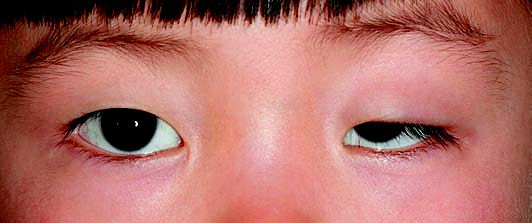Ptosis refers to a condition where the upper eyelid is partially or completely unable to elevate due to dysfunction or loss of function in the levator palpebrae superioris and Müller's muscle. When the eye is naturally open and gazing forward, the upper eyelid covers more than 2 mm of the upper edge of the cornea. Mild cases may not cover the pupil but affect appearance, while severe cases partially or entirely obstruct the pupil, impairing visual function. Ptosis can be congenital or acquired. Congenital ptosis is primarily caused by underdevelopment of the oculomotor nerve nucleus or the levator palpebrae superioris, which follows either autosomal dominant or recessive inheritance patterns. Acquired ptosis is associated with factors such as oculomotor nerve palsy, levator muscle injury, sympathetic nerve dysfunction, myasthenia gravis, or mechanical obstruction of eyelid movement.
Clinical Manifestations
Congenital Ptosis
This is often bilateral but not necessarily symmetrical, and sometimes unilateral. It may be accompanied by limited upward eye movement. If the pupil is obstructed, patients may compensate for their impaired vision by tightening the frontal muscle, leading to pronounced transverse skin wrinkles and raising of the eyebrows, or by tilting their heads backward for an unobstructed view.

Figure 1 Appearance of congenital ptosis in the left eye
The patient's left upper eyelid covers half of the pupil.
Acquired Ptosis
This is frequently associated with medical history or other symptoms. Oculomotor nerve palsy may be accompanied by paralysis of other extraocular muscles. Sympathetic nerve damage may present as part of Horner's syndrome. Ptosis caused by myasthenia gravis often exhibits a diurnal variation, characterized by a tendency to worsen by evening and improvement after neostigmine injection.
Diagnosis
Diagnosis is typically established based on the patient's medical history and clinical manifestations.
Treatment
Congenital Ptosis
Surgical intervention is the main approach. For cases where the pupil is obstructed, surgery is recommended around the age of three to prevent amblyopia. For unilateral cases, surgery may be performed earlier if necessary.
Acquired Ptosis
Treatment involves addressing the underlying cause or pharmacological management. Surgery may be considered if necessary.
The specific surgical method is chosen based on the strength of the levator muscle and includes options such as levator muscle shortening or frontalis muscle flap suspension.